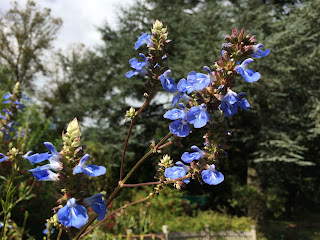By Helen Roberts
It’s the time of year when most people think that gardens are nearing the end of the full flush of summer blooms. Mid summer flowers may be dwindling but there are numerous late flowering species that still provide a riot of colour. I have always been interested in gardens at this time of year because we are often rewarded with a spell of bright sunny weather in autumn. I want to be outside enjoying the garden, hanging onto the summer for as long as I can before the cold deepens and the nights draw in. So planning for some autumn colour in the garden can be very rewarding.
With thoughts of designing my own garden for a prolonged season of flowering, an excursion to the University of Bristol Botanic Garden was due. I met up with Froggie who showed me the bounty of colour at this time of year in the gardens.
First stop was the hot borders which can be found in front of The Holmes, which were evidently at their most scorching in terms of vivid colours, with swathes of Hemerocallis, Penstemon, Helenium, Rudbeckia, Tithonia, Fuchsia and Dahlia. Froggie pointed out the lovely Verbena bonariensis, which is such a great plant for pollinators and one that self seeds profusely. Verbena adds some soft architectural form to borders and provides flowers for months on end. A plant that I was less familiar with was the rather cute and tender Cuphea cyanea or Cigar flower with red and yellow tipped flowers. There is also another variety of Cuphea called the Pink Mouse – each flower does look like a miniscule mouse!
Providing structure to the hot borders were the awesome sub tropical Abyssinian Banana (Ensete ventricosum), which were still looking amazing but will soon be lifted and taken into the greenhouses. The staff keep a close eye on the weather at this time of year, any sign of frost forecast and they must move quickly to take in the tender species.
Froggie explained, “We had some hard winters a few years back and we lost quite a lot of plants so lifting plants into the greenhouses ensures they are protected. They are our insurance against a very cold winter.”
 |
| Salvia uliginosa can be found flowering this time of year by the Botanic Garden’s main pond. Photo credit: Helen Roberts. |
Many of the shrubby salvias are in this tender category. Froggie showed me Salvia confertiflora, an exotic late flowering species with beautiful fuzzy crimson inflorescences about 0.5m tall. This will be moved inside soon when the weather cools. Another that caught my eye in the pollinator beds located on one side of the main pond was Salvia uliginosa, a very tall plant with vibrant sky blue inflorescences that were buzzing with bumblebees.
I have to admit to an obsession with shrubby salvias, which started after many visits to the garden of plant guru Derry Watkins over the course of this summer. Her passion for these beautiful plants is contagious. They are an extraordinary group of plants that flower continuously from June until October and the flower colours are exquisite. The colours really pack a punch in terms of vividness. I purchased Salvia microphylla ‘Cerro Potosi’, which started producing vibrant magenta flowers back in June and is still putting on a show of pink in October. I plan to take cuttings of this to provide a back up plan in case I lose my original plant (I am going to risk leaving mine out over winter).
| Toad Lilies (Tricyrtis macropoda). Photo credit: Helen Roberts. |
In amongst the buzzing pollinator borders were the very pretty and delicate Toad Lilies (Tricyrtis macropoda). I watched bees visiting these inflorescences and collecting nectar by robbing it through the back of the flowers. The pink flowered society garlic (Tulbaghia violacea) and Japanese Anemone (Anemone hupehensis) were very subtle in hue combined with dazzling yellow Rudbeckia and deep purple drooping flowers of Agapanthus inapertus ‘Midnight Cascade’. Many of the hummingbird-pollinated plants were in flower including the pineapple relative Ochagavia litoralis and the terrestrial bromeliad Fascicularia pitcairnifolia. The latter, at present, is visually screaming, “Come pollinate me!” with the centre of the rosette turning an intense scarlet with a dense cluster of blue flowers tipped with bright yellow pollen.
Throughout the gardens, as I toured around with Froggie, there were interesting flowering species and the colours varied tremendously from vivid red and pink to deepest indigo. The flower forms were diverse too; delicate dangling umbels, ‘in your face’ discs of blooms, hooked and lipped nectar-rich inflorescences and some which were just plain weird looking. The gardens simply still looked stunning and I left knowing that it’s not yet time to put gardens to bed, there’s plenty more flowers to come.
More species that are flowering now in the garden include:
- Abutilon sp. (Chinese lantern)
- Agastache sp. (Giant hyssop)
- Campsis sp. (Trumpet vine)
- Caryopteris x clandonensis (Bluebeard)
- Colchicum agrippinum
- Commelina tuberosa Coelestis Group (Day flower or Sleeping Beauty)
- Crinodendron hookerianum (Chilean lantern tree)
- Erica tetralix (Cross-leaved heath)
- Impatiens tinctoria
- Lantana camara (Yellow sage)
- Liriope muscari (Big blue lily turf)
- Tropaeolum peregrinum (Canary creeper)
- Verbena peruviana (Peruvian verbena)

